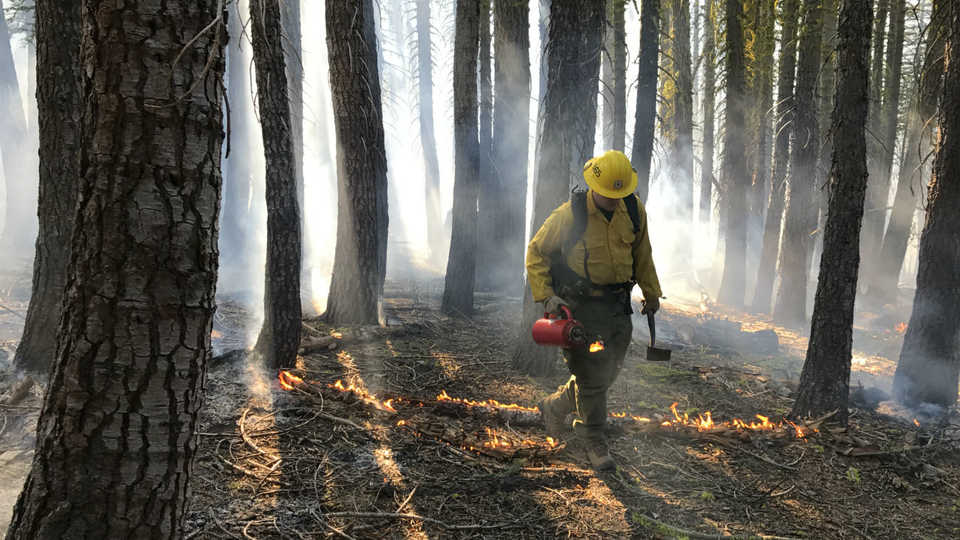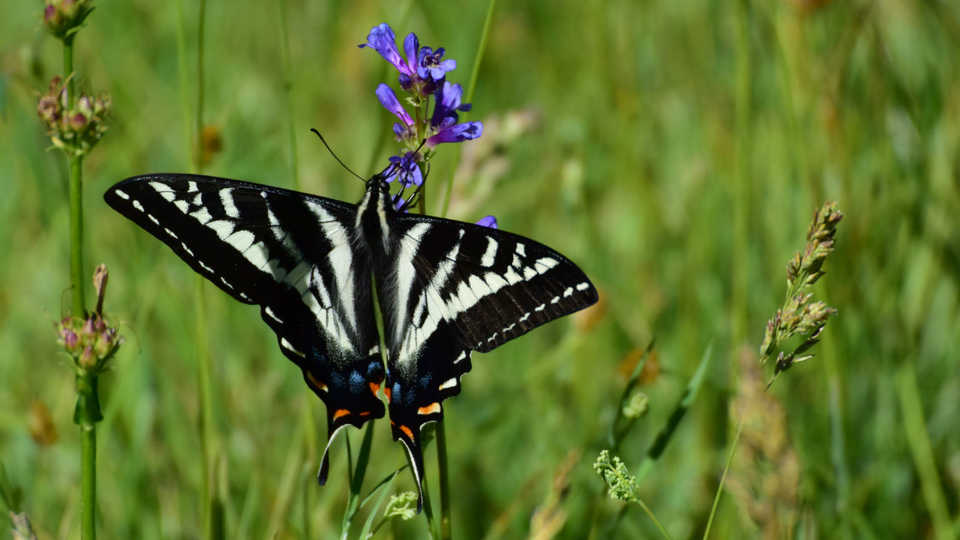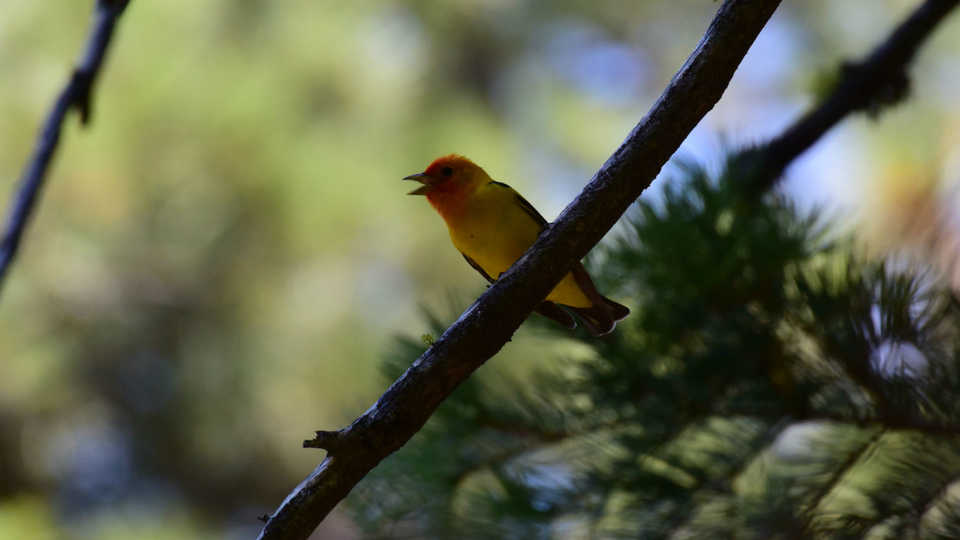How can we avoid megafires? A healthy stretch of forest near Lake Tahoe hints that active management is the key to enhancing forest resilience in California and beyond.
SAN FRANCISCO (February 13, 2018) – As the state recovers from devastating fires in the north and south, a team of California-based scientists is taking a deeper look at forest resilience in the face of future fires. A collaborative team of multidisciplinary researchers from the California Academy of Sciences and the U.S. Forest Service’s Pacific Southwest Research Station (PSW) are investigating a forested Northern California watershed—and its birds—to determine how controlled fires may contribute to healthier forest ecosystems and reduce the risk of high intensity wildfires. By surveying birds and local conditions in a forest targeted for controlled burns, the team will capture a multi-year picture of what fuel-heavy ecosystems look like before a fire, how they respond to controlled fire in the near-term, and how they might change if a wildfire occurs down the road.
“California forests are treasures to the wildlife and people of our state,” says Durrell Kapan, senior research fellow at the California Academy of Sciences and a co-leader of the resiliency project. “There couldn't be a more important time to research the impacts of forest fires—especially the role of supervised, controlled burns to reduce the risk of extreme burns. Our group is interested in understanding how to manage forests in a healthy way so we can avoid the devastating megafires that often follow drought and disease.”
The first survey results point to the importance of regular prescribed burns to keep healthy forests thriving and nearby communities safer from catastrophic wildfires. The five-year scientific survey and outreach program, which launched this past spring on the 20,236-acre Caples Creek watershed along the South Fork of the American River, will continue in spring 2018.
Fire, climate, and a “study” forest
The frequency and intensity of the West’s wildland fires are increased by global climate change. Earth’s changing climate has contributed to more variable bouts of extreme wet or drought, which can include drier soils and longer fire seasons—conditions that increase the likelihood of intense, more dangerous fires that are difficult to control. Combined with our country’s long history of suppressing fire in our forests, current conditions are making way for severe, record-breaking wildfires up and down California.
In the face of climate impacts, widespread regional tree death, and longer, more catastrophic fire seasons across the state, scientists from the Academy and PSW teamed up to identify a study region that might be used as a stand-in for forests elsewhere. Unlike some forests in its nearby neighbor, the Lake Tahoe Basin, much of the forest land in the Caples Creek watershed has been fire-free for more than 80 to 100 years, meaning the forest floor has a large amount of “fuel”—dead trees and layers of vegetation built up over time—and is susceptible to major fires in the future.
“The Caples Creek watershed has a long history of fire suppression, but otherwise it has not been significantly altered by people,” says Pat Manley, PSW’s Conservation of Biodiversity research program manager. “It has incredible natural resources, biodiversity, and a variety of forest types that are a great fit for this type of study of how to use prescribed fire to maintain and enhance forest resilience.”
Birds as ecosystem indicators
In summer 2017, scientists from the Academy—including Kapan and Jack Dumbacher, curator of ornithology and mammalogy—joined PSW in surveying the birds of the Caples Creek study area before any scheduled prescribed burns. The team is interested in how birds currently depend on the watershed’s diverse habitats, as well as how they will respond to future fire. Eighty-three study sites throughout the 20,236-acre watershed were chosen both inside and outside the area planned for controlled burns. Over the course of the first summer survey, the team detected 45 bird species (from 1,700 individual birds) and measured vegetation at each site to see how fire changes ecosystems over time.
“There’s a method to the madness of surveying forest birds,” says Dumbacher. “We spend 10 ultra-quiet minutes in each site, and watch and listen for any birds around us. When we look at the data from the first pre-burn survey, we see that different birds depend on all different parts of a healthy forest to survive. We’ll return to these sites to see what changes in the years to come as prescribed burns roll out and the ecosystem changes.”
A five-year plan
One way to reduce severe fires is to decrease fuel wood by reintroducing smaller fires to the forest at the right time of year—during times when the forest floor and woody vegetation have a lot of moisture from rain or snow. This past fall, the Forest Service launched its five-year project of controlled burns in the Caples Creek watershed with hand tools and careful planning. Managers take into account winds, moisture, and temperature to minimize the risk of burning more than accumulated forest fuel.
“Forests need fire to thrive and keep our human communities safer,” says Kapan, “but we need a better understanding of how certain management techniques impact wildlife. Forest managers, scientists, private landowners, and communities, you name it—we’re all adapting to a new climate and fire reality in California. Forests are always cycling and changing, and we want to help identify the most natural, cost-effective path to lasting resilience.”
Following a pre-survey this spring, Academy and PSW scientists will return for the second year of bird surveys during late spring. The Academy, an institution with a history of more than 150 years of California biodiversity research, and the team from PSW hope to continue monitoring the impacts of multi-year fuel reduction on the forest ecosystem—birds, trees, and more—through 2022.
The Institute for Biodiversity Science and Sustainability at the California Academy of Sciences is at the forefront of efforts to understand two of the most important topics of our time: the nature and sustainability of life on Earth. Based in San Francisco, the Institute is home to more than 100 world-class scientists, state-of-the-art facilities, and nearly 46 million scientific specimens from around the world. The Institute also leverages the expertise and efforts of more than 100 international Associates and 400 distinguished Fellows. Through expeditions around the globe, investigations in the lab, and analysis of vast biological datasets, the Institute’s scientists work to understand the evolution and interconnectedness of organisms and ecosystems, the threats they face around the world, and the most effective strategies for sustaining them into the future. Through innovative partnerships and public engagement initiatives, they also guide critical sustainability and conservation decisions worldwide, inspire and mentor the next generation of scientists, and foster responsible stewardship of our planet.
Headquartered in Albany, California, the Pacific Southwest Research Station is part of the U.S. Forest Service’s Research and Development branch developing and communicating science needed to sustain forest ecosystems and other benefits to nature and society. Pacific Southwest Research Station scientists are engaged in research across a network of 14 experimental watersheds, ranges and forests and eight research facilities in California, Hawaii and the U.S.–affiliated Pacific Islands. Research is organized into five research units: conservation of biodiversity, ecosystem function and health, fire and fuels, urban ecosystems and social dynamics, as well as Pacific Islands forestry. For more information, visit fs.fed.us/psw.
Press Contacts
If you are a journalist and would like to receive Academy press releases please contact press@calacademy.org.
Digital Assets
Hi-res and low-res image downloads are available for editorial use. Contact us at press@calacademy.org to request access.



